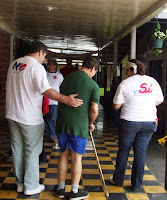When I was preparing to go out that Sunday morning to begin the task as an observer, my host brother told me that he had already voted. So I learned that the polling stations opened as early as 6AM, particularly in Ciudad Colon.
From Ciudad Colon where most of the 27 international observers from UPeace are staying, a bus brought us to Raddison Hotel in San Jose, the capital of Costa Rica, for a briefing. After that, we were ready to go.
Few cars were plying the streets of San Jose. Most shops were closed. Near the churches and polling stations were the cars mostly concentrated and parked that day. Most Cantones (Towns) in Costa Rica have their church, government hall, school, and plaza near each others’ location.
Polling stations were inside the schools. Outside the schools, there were the unmistakable booths of the two sides, YES and NO camps. Vendors of campaign paraphernalias, drinks and snacks were stationed near the school. People were free to express their stance on the issue by wearing campaign T-shirts, pins, caps, and henna tattoos on their faces and bellies. Voters came at the polling stations with their kids and family. I saw children and young people playing with football inside the school or simply running and playing around. People were greeting each other left and right and exchanging pleasantries, causing narrow hallways congested with people. It was a festive and jovial atmosphere.
Notably prior to the election date, I witnessed a huge gathering of those who opposed TLC at downtown San Jose. It was estimated that more than 100,000 people were in attendance – the biggest assembly in a country of more than 4 million people. Sea of people poured in the main street of San Jose wearing the flag colors. Music was coming from loud speakers and also from drum and bugle corps, and people were just bouncing to the rhythm of the music. Vendors were selling souvenirs and food. It was a festival. Yet it was also a protest against TLC. During speeches, people were attentive and applauded intermittent instances with the deafening chant of NO T-L-C which sent emotions high. I felt it when my heartbeat pumped rapidly; my bones felt weak; and sudden coldness breezed causing a certain tightness on my skin.
When voting, people had to look at their names on the list of voters posted outside a polling room. Each list had a maximum number of voters of 700. Only three voters at a time were allowed inside the room. Inside a polling room, voters presented their national ID or “cedula” with pictures. Then, they got a ballot and filled that ballot with their choice.
With my little Spanish, I was able to chat with one voter outside a school. I asked him if he lives near the polling station. The man said that his place is far, but he was waiting for a bus commissioned by the Electoral Tribunal to fetch and pick voters from far places. Incidentally, I saw a bus coming with a Si (Yes) posters infront of it and on the sides. The man got inside the bus and waved at me when he got his seat.
After visiting three schools, we decided to go to the office of the Electoral Tribunal. Inside, we saw a hundred people queuing either to have their new cedula or renew it.
In the evening, we were invited to the announcement of a preliminary result at the Electoral Tribunal office. Outside the building, there were about 20 young people who were shouting NO T-L-C. People inside the building were unmindful of what was going on outside. At 9 PM, the tribunal announced that the Si (YES) was leading the No by a slim margin of 51.6% to 48.4% of nearly 60% turn out. To make it binding, the referendum is required to have at least 40% turn out.
There was an immediate celebration of the Yes camp at the La Sabana Park while there were also some reports of disturbances like burning of posters and street signs in the city by unidentified people. But no killings related to the referendum were reported.
The president of the country and a Nobel Peace Laureate, Oscar Arias, called on the No camp for reconciliation. However, some people in the No camp rejected this and cited electoral fraud and anomalies.
To be part of this political exercise in a foreign country especially in Costa Rica was quite an experience. I saw a fair, peaceful, and orderly election. It was what Costarincces take pride on what they have become and what they could offer to the world, aside from their abolition of their army.

No comments:
Post a Comment